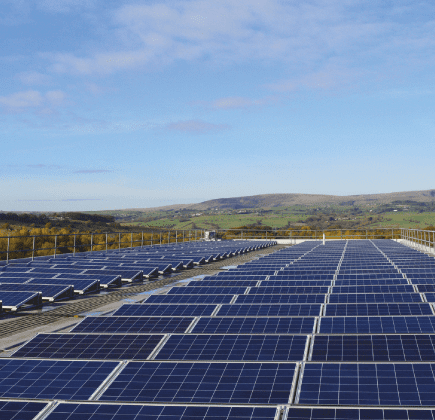
What will it take for the UK to reach Net Zero by 2050?
By now, you’re probably already at least passingly familiar with the term Net Zero. The concept was developed in recognition of the fact that right now, it’s basically impossible to remove our global emissions to zero, even with the help of low carbon technologies like commercial solar panels. A much more achievable target, though, involves reaching a stage when we’re successfully removing as many emissions as we’re putting into the Earth’s atmosphere. That’s Net Zero.
And with global temperatures rising, the world’s governments are becoming increasingly aware of the need to take urgent action. In June 2019, the UK became the first major country to make a legally binding commitment to achieving Net Zero by 2050. Even with the bulk of thirty years to go, it’s still an ambitious target, and one that needs a concerted national effort to achieve. So, what needs to happen in each UK sector for us to achieve it?
Energy generation
One of our most crucial short-term objectives for the energy sector is, of course, the phasing out of coal. The notoriously dirty fuel has already been in decline for quite some time, and in 2019, the emergence of the Covid-19 pandemic caused that decline to accelerate. Another major priority is gas, which is currently widely used in domestic buildings across the UK.
Despite their decline, replacing coal and natural gas entirely is still no easy task, and the government still has some work to do on its plans for the large-scale rollout of renewable technologies in their place. (It’s especially worth noting that offshore wind and solar PV are now some of the lowest-cost forms of power generation in the UK.) Carbon capture and storage should be another major item on the government’s green agenda. They’re creating some unease as things stand, because of the expense involved, but they’re highly effective measures against rising emissions levels.
Personal and public transport
The most pressing priority for cars and vans can be summed up in a single word: electrification. As of the time of writing, there are just over a quarter of a million (260,000) electric vehicles in the UK, and that number is rising all the time. They’re expected to start completely superseding existing petrol and diesel vehicles within the next decade, as the government has already pledged to ban the sale of all new petrol and diesel cars by 2030.
But while businesses can already see a huge range of benefits from electrifying their commercial fleets, it seems like the general public at large will still need some persuading though, as currently less than 5% of households use all-electric or hybrid cars. In the meantime, there needs to be a greater focus on alternative low-carbon ways of travel, like walking, cycling, and public transport.
Speaking of public transport, experts at the Climate Change Committee have also stressed the need for a national overhaul there too. The panel has specifically highlighted the need for a new rail electrification programme, which would reduce emissions from the diesel engines that are currently widely in use.
Aviation is a particular sticking point, as it’s widely acknowledged that it will be extremely difficult – if not impossible – for the sector to achieve Net Zero by 2050 as things stand. Up until now, it’s been attempting to go with a carbon offsetting strategy through the planting of trees, but that’s recently been deemed to be insufficient, and there have been calls for the sector to take more proactive steps towards more expensive carbon capture and storage technologies.
Property and construction
40% of the UK’s carbon footprint falls under it’s ‘built environment’, so this is another area in which significant strides need to be made for it to become more climate-friendly. Currently, the majority of domestic (and many commercial) buildings throughout the UK have been built to now-obsolete standards, so they’re more expensive, difficult and carbon-intensive to effectively heat and power. For that reason alone, repurposing and refurbishing buildings to make them more carbon-friendly is one of the biggest priorities for the sector.
New builds also need to be carefully planned with sustainability in mind, specifically with a focus on making them more cost-effective and efficient to heat and power. More attention will be paid to ventilation and lighting, minimising the reliance on boilers and artificial lighting so that owners can save energy and cut down on their carbon footprint.
And it’s not just the buildings themselves that are being overhauled – the construction processes themselves are being put under fresh scrutiny. The usage of concrete in particular is a critical concern. Though its practical uses are undeniable, its manufacture generates a worrying level of carbon emissions. In fact, if it were a country, it would be the world’s third largest emitter. Various initiatives are experimenting with additives and other innovations that could reduce its polluting nature, but really an ideal vision for the future would involve not using it at all.
Industry
Just like aviation, the nature of many processes in heavy industry means that it’s notably difficult to bring down emissions levels in this field. While slow progress is being made to develop carbon-friendly alternatives to firmly established heavy industry processes, many business owners are looking to minimise their emissions as much as they can in the meantime, through a range of co-ordinated measures.
We’re sure you’ve guessed one of them – commercial solar PV for warehouses and similar large-scale premises is a great way for business owners to put otherwise-underutilised space to good use, cutting down on their energy costs and carbon footprint. A number of other low-carbon solutions are also being explored, including carbon capture and storage, the development of hydrogen technologies, and electrification.
The government is also attempting to provide incentives for businesses to minimise their carbon emissions through the use of a UK Emissions Trading Scheme (UK ETS). This replaced the European Union’s ETS, which Britain left in 2021 upon its exit from the EU. The national scheme is modelled closely on its EU counterpart, although there are one or two important differences.
Farming and agriculture
When it comes to agriculture, one of the most pressing priorities is to enable farmers to make better use of their land. Better management of livestock and soil are areas of particular focus; mismanaged soil can be a significant source of carbon emissions, but if it’s managed well, then it can actually act as a ‘carbon sink’, absorbing more carbon from the atmosphere than it releases.
The Climate Change Committee would like to see about a fifth of agricultural land being used to grow trees or energy crops, or just restored into peatland. But this isn’t a task for famers alone – the panel have stressed that the best way for the nation to support this is through a country-wide switch to healthier diets, and minimising food wastage.
Trees are perhaps the most famous for their carbon sinking abilities, so it’s probably no surprise that the CCC has made note of their importance in the mission to reach Net Zero. According to the panel, 20,000 trees need to be planted a year, but so far the government is falling well short of those targets, with less than half of this number being planted over the course of the past five years.
Ministers are already making an effort to galvanise this with a post-Brexit agricultural bill. If passed by parliament, this would reward farmers who were able to demonstrably prove that they were making a positive impact on the environment.
A ‘Just Transition’
This is perhaps the most vague item on the list, but no less important. Phasing out carbon-intensive technologies and industries isn’t just a matter of logistics – it has a very real human cost, too. For a particularly notorious example of this, you need look no further than the closure of numerous coal mines by Margaret Thatcher back in the 1980s, which devastated entire communities. Modern commentators have stressed the importance of avoiding a repeat of that dark bit of history, as we move towards a brighter future. This is what is meant by a ‘just transition’ – the UK’s responsibility to support all citizens whose livelihoods are dependent on these polluting industries, and ensure that they are not left behind in the same way as we transition to a new form of economy.
On the surface of it, our journey to Net Zero occupies a strange position in terms of how humans perceive time. On a global, species-wide level, thirty years will be gone in a heartbeat. Countless technologies, economies, policies and cultural attitudes can evolve in that sort of timescale. But for each of us individually, three decades is a significant proportion of our lives – so as a nation, while we now know where we’re going, it might be a little while before we can accurately gauge how well we’re doing on getting there.
But – and we hope you’ll excuse us for extending the metaphor – if you’re looking to take the next steps on your own organisation’s journey with commercial solar panels, that’s exactly where we can help here at Low Carbon Energy. With 30 years of combined expertise to our name, you can count on us to help you use solar panels to achieve your Net Zero targets. Feel free to take a look through our case studies for just a couple of examples of what we can do – or to find out how we can help you, just give us a call on 01282 421 489!
 Energy Technology
Energy Technology

Powering your present. Preserving your future.
Call us on 01282 421 489

strategy be a priority?












